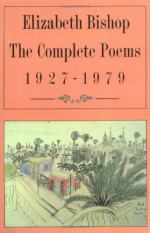
|
| Name: _________________________ | Period: ___________________ |
This test consists of 5 multiple choice questions, 5 short answer questions, and 10 short essay questions.
Multiple Choice Questions
1. What is the meaning of the word "fluster" in line 4?
(a) Sudden, uncoordinated movement.
(b) Humorous coincidence.
(c) Confused agitation.
(d) Tiring inconvenience.
2. What is the rhyme scheme of the first five stanzas of "One Art"?
(a) ABA.
(b) ABB.
(c) AAB.
(d) AAA.
3. Which is the best description of the tone of stanza one?
(a) Livid.
(b) Bewildered.
(c) Ebullient.
(d) Sanguine.
4. In the first stanza, what does the speaker suggest makes the loss of some things especially easy to accept?
(a) They are part of a distant past.
(b) They are small and insignificant.
(c) They are difficult to live with.
(d) They seem to want to get lost.
5. What is the format of "One Art"?
(a) Villanelle.
(b) Ballad.
(c) Sestina.
(d) Sonnet.
Short Answer Questions
1. How many stanzas does "One Art" have?
2. Lines 4 and 6, ending in the words "fluster" and "master," exhibit what type of rhyme?
3. Which technique is used in the speaker's claim to have lost "some realms I owned, two rivers, a continent" (line 14)?
4. How many lines does "One Art" have?
5. What is the verb mood of line 4, "Lose something every day"?
Short Essay Questions
1. What are the refrains employed in "One Art"?
2. To whom is the parenthetical comment "(Write it!)" addressed in line 19, and how does this comment impact the reader's understanding of the poem?
3. Describe the form of "One Art."
4. What difference is there in the way the two refrain lines are repeated throughout the poem?
5. How does the speaker's diction increase the emotional stakes as the poem progresses?
6. What is the poem's dominant meter, and how is it regularly interrupted?
7. On the surface level, what is the main message of "One Art"?
8. Which two verb moods are used in "One Art," and where are they employed?
9. How does the change in stanza structure in the final stanza mimic the poem's changing meaning?
10. How does the speaker arrange the examples of things that can be lost?
|
This section contains 818 words (approx. 3 pages at 300 words per page) |

|




